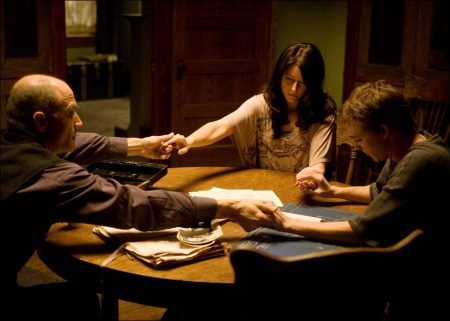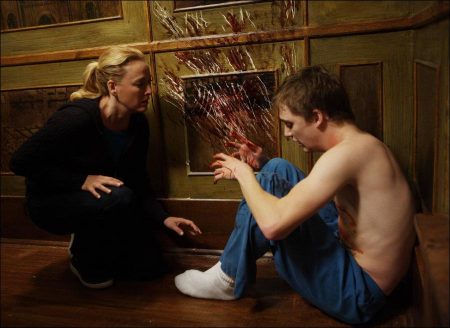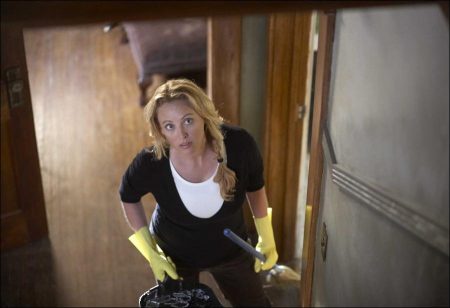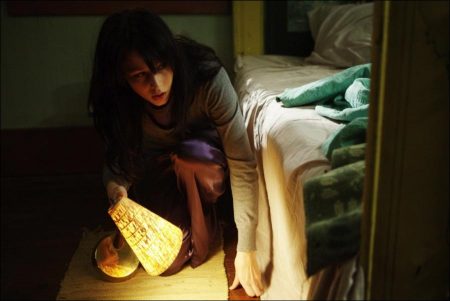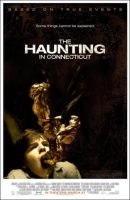Tagline: Some things cannot be explained.
Based on a chilling true story, Lionsgate’s “The Haunting in Connecticut” charts one family’s terrifying, real-life encounter with the dark forces of the supernatural. When the Campbell family moves to upstate Connecticut, they soon learn that their charming Victorian home has a disturbing history: not only was the house a transformed funeral parlor where inconceivable acts occurred, but the owner’s clairvoyant son Jonah served as a demonic messenger, providing a gateway for spiritual entities to crossover. Now unspeakable terror awaits, when Jonah, the boy who communicated with the powerful dark forces of the supernatural, returns to unleash a new kind of horror on the innocent and unsuspecting family.
In the tradition of such real-life horror movies as “The Exorcist” and “The Exorcism of Emily Rose,” “The Haunting in Connecticut” tells the astounding true story of one family’s supernatural ordeal. When Sara and Peter Campbell’s son Matt is diagnosed with cancer, they uproot their family to Connecticut for his treatment.
The Haunting in Connecticut is a 2009 American psychological horror film produced by Gold Circle Films and directed by Peter Cornwell. The film is alleged to be about Carmen Snedeker and her family, though Ray Garton, author of In a Dark Place: The Story of a True Haunting (1992), has publicly distanced himself from the accuracy of the events he depicted in the book.[1][2] The film’s story follows the fictional Campbells as they move into a house (a former mortuary) to mitigate the strains of travel on their cancer-stricken son, Matthew. The family soon becomes haunted by violent and traumatic events from supernatural forces occupying the house.
Although it was a moderately successful film at the box office (it grossed $77,527,732), it received “generally unfavorable reviews” according to Metacritic. In 2010 Gold Circle Films announced the production of two more entries in the franchise, The Haunting in Connecticut 2: Ghosts of Georgia (released 2013) and The Amityville Murders: A Haunting on Long Island. They noted, however, that neither film would be a direct sequel to The Haunting in Connecticut and would instead be self-contained films with unique characters.
About the Production
The history of the United States is teeming with ghosts. Tales of haunted houses and legends of the malevolent dead may be found particularly among the records of New England and the Tri-State area. In Connecticut, entire villages have disappeared as a result of hauntings. In the northwest region of the state, residents of Dudleytown were driven insane en masse after an entire generation of spirit attacks destroyed their hopes.
In 1987, a particularly nightmarish haunting occurred in Connecticut town of Southington to a family that had just moved in to a long empty house on Meriden Avenue. Soon after settling in, the family discovered a small graveyard in back, an embalming chamber in the basement, and drawers full of eerie corpse photographs: their new house had previously been a Funeral Home dating back to the 1920s.
Almost immediately, the family began to experience paranormal activity – strange sounds, changes in temperature, the appearance of mysterious figures which were so intense and frequent it nearly destroyed them. All the while, they remained unaware that their experiences comprised one of the most extreme and convincing cases of supernatural activity ever recorded.
The making of THE HAUNTING IN CONNECTICUT began in 2003, when producer Andrew Trapani viewed a televised documentary about the unimaginable horrors withstood by Carmen Reed and her family. Trapani sat riveted, and once it was over, set out to find Reed so he could speak with her firsthand. After hearing her account, Trapani and producer Paul Brooks were stunned. Her story was unprecedented and demanded to be told. Remarked Brooks, “The fact that all these paranormal attacks occurred in a span of months to different members of that family is incredible.”
Director Peter Cornwell also found this particular story very compelling. “It only makes the things that happen to them more terrifying,” says Cornwell, “when you can genuinely relate to them as real people and not just characters in a film.”
For writers Adam Simon and Tim Metcalfe, THE HAUNTING IN CONNECTICUT was the perfect opportunity to put their life-long fascination with the supernatural to good use. Explains Metcalfe, “Our mutual interest in the occult as represented in literature, film and history really helped shape the story.” Avid students of Victorian horror and the Spiritualist movement, the writing partners skillfully wove their knowledge of the era into the script.s backstory, which features instances of horrific mutilation, séances and the macabre.
Following the release of his award-winning animated short film, “Ward 13,” director Peter Cornwell attracted considerable attention among Hollywood producers. “Peter.s short film was genuinely scary and it had so much soul,” recalls Brooks. “I thought he had a genuinely original point of view. And he agreed that HAUNTING should be rooted in reality and essentially faithful to the family.s story.”
Coincidentally, Cornwell himself was eager to explore live-action filmmaking on a feature-length scale. “In animation, you really have to see the scenes very clearly in your head before you can shoot them,” explains the director. “In live action, you collaborate with the actors, who have their own ideas. It is great collaborating and creating with the involvement of other people in the scene.”
Oscar-nominated actress Virginia Madsen, who earned cult status among horror fans for her compelling performance in Bernard Rose’s CANDYMAN, had been looking for a script in the horror genre for about three years. But the twenty-five or more screenplays she had read mostly resorted to cheap scare tactics involving torture and excessive gore.
“Then I got this script with a great story and a complex female character in Sara Campbell…and it scared me to death,” she says. Like Carmen Reed, Campbell is a strong, religious woman who struggles to hold her family together while experiencing a crisis of faith at the hands of the evil in her very own home.
While Madsen admits that she hasn.t always had satisfying experiences working with first-time directors, Cornwell.s thorough preparation and clear vision for the film won her over. “When I met Peter, it.s like we were kinda like two big kids. I love movies, I love scary movies and so does he. And I wanted to find out all about the short film that he made. So we just hit it off right away, I think, in a very childlike way. But there is a side of Peter that I also found to be very focused and very sure of the kind film he was going to make.”
“Virginia was truly a dream to work with,” says Cornwell. “She.s someone with amazing caliber, experience and presence.” Amidst the dark atmosphere of the project, Madsen was protective of the young actors who play her children on screen and offered her full support to them throughout the production, earning the moniker „Mama V.. Amanda Crew, who plays Sara.s niece Wendy, says “Virginia recognized that we needed her support to get this difficult story. Like the mother in the film, she was the guiding light for us on set.”
For young actor Kyle Gallner, known primarily for his work on the series “Veronica Mars,” playing Matt Campbell was a formidable challenge. Not only was it his first lead role in a feature, but the character required considerable emotional range: Matt must grapple with a strained relationship with his mother as well as repeated visitations from his doppelganger, a charred, seemingly evil boy named Jonah. “The part was intimidating,” says Gallner, “and very intense for me. And we were only shooting a movie. It.s unimaginable to me what it must have been like for the family at that time.”
Being a teenager himself, Gallner offered his own ideas to the filmmakers so that Matt would be as authentic a character as possible. “Kyle is the one who.s sixteen,” says Cornwell, “so I was happy to get his input about how a kid of that age would react. I helped him find a way of playing the scenes so they felt real and that he could believe in. But it is truly Kyle.s talent that brings the character of Matt to life.”
Madsen, who is the mother of a thirteen-year-old, appreciated the complexities of the mother / son relationship depicted in the script. As Matt experiences increasingly terrifying visions, he grapples with how much to reveal to his mother, whom he doesn.t want to further upset. “Most films portray teens as dysfunctional, messed up and hating their parents. Teens are much more complex than that,” offers Madsen. “I found the Sara-Matt relationship to be a very truthful representation of parents and teenagers.”
Actor Elias Koteas, who plays Reverend Popescu, a priest who tries to help the Campbells, impressed Cornwell with his dedication to his work, particularly his habit of staying in character in between takes. Madsen, who had previously worked with Koteas and regards him as a truly gifted actor who delves deeply into the parts he plays, refers to him as “The Zen Man.” Reports Cornwell, “Elias brought a lot of soul to the character. He works really hard and he’s really dedicated to getting the details right. He.s willing to go places that aren.t necessarily comfortable for him.”
Martin Donovan plays Peter, the well-meaning father who buckles under the financial pressure facing his family. Donovan particularly appreciated the script.s focus on character, which he found unique to the horror genre. “I raised the idea of guilt and rage with the director, since they seemed to be undercurrents of Peter.s experience,” says Donovan. “Peter is torn in a lot of directions. I have great empathy for him.”
Rounding out the principal cast is Amanda Crew, who plays Matt.s cousin Wendy. Crew was attracted to the script for its scares, and got spooked herself shooting a scene involving an ax bludgeoning a door. “By the second take, that ax got so close to my face that my heart was pounding through my chest,” Crew recalls. “That wasn.t acting. It was truly scary.”
Perhaps the most pivotal role in the film, however, is that of the house itself. Says Screenwriter Adam Simon, “The house has to be a major character, arguably THE major character. And you then are dealing with the real burden of history too, you know. For example, Hill House from The Haunting of Hill House, the Overlook Hotel from The Shining. It.s very daunting to attempt to create in that sense a haunted house. On the other hand, we had some things really going for us here which was this idea, the reality, the truth that this house had been a mortuary.”
Cornwell, working with production designer Alicia Keywan, searched extensively for the perfect location, eventually finding the ideal Victorian home in the town of Teulon, about 30 minutes outside of downtown Winnipeg, Canada. “On most productions, you’re traveling around so often to different locations you don’t really get very familiar with one particular place. I like the intimacy of getting to know the house as a character,” Cornwell explains.
Remarks Madsen, “The house almost had a face. It just felt scary being in it.” Surrounded by a large piece of land, with distinctive round windows and a long classic driveway, the house doubled perfectly as a Connecticut Victorian. The basement and bedroom where Matt sleeps were constructed on a sound stage. Working with Cornwell and director of photography Adam Swica, Keywan produced 3-D models of the house so that a variety of technical sequences could be worked out before production began. Swica adopted a classic approach to shooting the film, choosing judiciously when to use handheld camera movements to create tension.
The corpses, created by award-winning FX artist Todd Masters (Emmy Award winner, „Best Special Effects Make-up,. “Six Feet Under” [2001 / 2002 season], Saturn Award winner, “Best Make-up FX,” Slither [2006]) and his team at the visual effects company, MASTERSFX, were prepared a month and a half prior to the shoot. Made of silicone with complete metal armature and welded joints, each body required two-weeks to complete, from molding a life cast to the painting of hair and application of tattoos. “You can.t get a more real dead body than what we have,” says Cornwell. “You touched them and they actually felt cold and stiff.”
“The corpses looked so real with their leg hair and chewed nails that I was physically repulsed by them,” avows Madsen. “And the funny part is that they were anatomically correct. Each guy had a penis. They gave them dignity by covering that area up. But I did peek since a girl.s got to have fun!”
While Cornwell doesn.t shy away from using special effects to heighten the film.s shocks, he believes this story will have no trouble unnerving even the most experienced horror fans. “It’s terrifying to see what this family went through,” he says. “I just tried to show what happened as faithfully as possible and felt it would then be scary.”
Carmen Reed herself was stunned by the experience of watching her own story on the screen. “I was cringing in my seat I was so terrified. It brought me back to those moments when I was just sure I was going to die, that we were all going to die,” she says. “Seeing it all up there again, I don.t know how we survived it.”
But she wanted her story told. “I want people to know that this does happen,” Reed explains. “Just because people see unexplainable things or hear voices doesn.t mean they.re crazy. We have to understand we don.t have all the answers. I didn.t believe in ghosts. I didn.t believe this could happen. And I rolled my eyes at people who claimed they existed, where every creak that.s in the house is ghost. But there are times when there actually is a monster under the bed.”
The Haunting in Connecticut (2009)
Directed by: Peter Cornwell
Starring: Virginia Madsen, Kyle Gallner, Martin Donovan, Elias Koteas, Amanda Crew, Sophi Knight, Erik J. Berg, John Bluethner, Adriana O’Neil, Will Woytowich, James Durham
Screenplay by: Adam Simon, Tim Metcalfe
Production Design by: Alicia Keywan
Cinematography by: Adam Swica
Film Editing by: Tom Elkins
Costume Design by: Meg McMillan
Set Decoration by: Craig Sandells, Steve Shewchuk
Art Direction by: Edward Bonutto
Music by: Robert J. Kral
MPAA Rating: PG-13 for some intense sequences of terror and disturbing images.
Distributed by: Lionsgate Films
Release Date: March 27, 2009
Visits: 63
